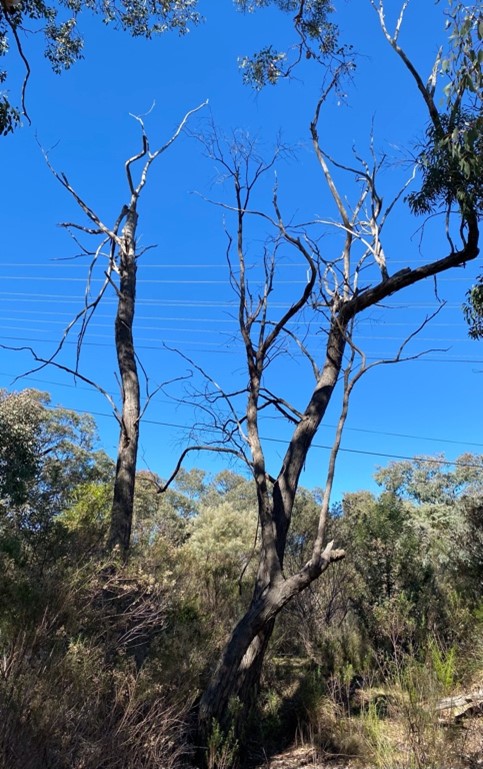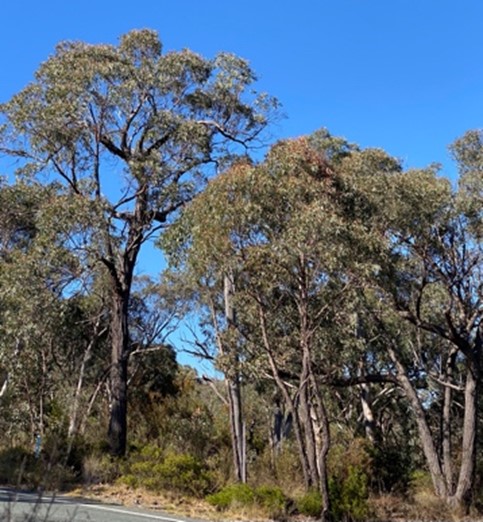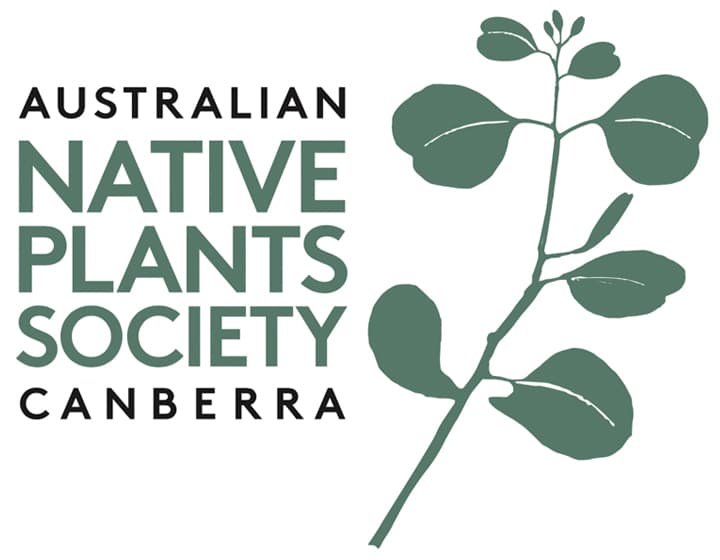Notes on the Dieback of Red Stringybark (Eucalyptus macrorhyncha) in the Queanbeyan Area
By Bill Willis, Horticulturist
May, 2024
Red Stringybark (Eucalyptus macrorhyncha) is a medium to tall tree <30m, with rough, grey bark that comes off in strings. It is a common species of Eucalyptus (gum trees) growing in woodlands and sclerophyll forests along the eastern ranges and western slopes of NSW and Victoria and in isolated areas (refugia) with an outlying population in South Australia restricted to the Clare Valley, over 500 km west of the trees’ distributions in Victoria. The Clare Valley has comparative aridity and altitude (600–800m) to the eastern escarpment east of Queanbeyan.
Disjunct populations of Eucalyptus macrorhyncha are growing on the eastern escarpment east of Queanbeyan, NSW and elsewhere. Queanbeyan Landcarers, and members of other walking groups, walking on the eastern escarpment have observed that populations of E. macrorhyncha (Red Stringybark) are showing signs of dieback. The very upper branches of the crown on a substantial number of trees are dead. Elsewhere within and beyond the borders of the ACT are disjunct populations of varying maturity. Here too E. macrorhyncha trees are showing observable signs of upper crown dieback. This form of dieback appears to progress downward from the very top of the crown.
However, E. macrorhyncha dieback was infrequently seen in some local colonies. On the southern side of Mount Jerrabomberra is a refugia of E. macrorhyncha with some large remnant E. macrorhyncha and a range of smaller trees relatively free of dieback. However, the more wind exposed and isolated western edge of this refugia the E. macrorhyncha are showing signs of dieback.


Fatal dieback, north facing site Greenleigh NSW
A recent paper by a research panel of the School of Biological Sciences (and elsewhere), University of Adelaide, SA., (Gunnar Keppel, et al), using repeat field surveys, investigated dieback in an isolated population of Eucalyptus macrorhyncha during two droughts in Clare Valley, SA, offers an insight into the causes of Eucalyptus macrorhyncha dieback.
“…hot, dry winds, was a significant positive predictor after the Big Dry only. This suggests that more marginal sites with low biomass and sites located on flat plateaus were more vulnerable initially, but that heat-stress was an important driver of dieback during the Big Dry. Therefore, the causative drivers of dieback may change during population decline.
“…Regeneration occurred predominantly on southern and eastern aspects, which would receive the least solar radiation…” Abstract, p.1

HIGHLIGHTS of the 15-year Clare Valley study
• We confirm a eucalypt population as unique and restricted to a Pleistocene refugium.
• Dieback through two droughts removed >40 % of individuals and biomass.
• Dieback occurred mostly in marginal sites after the first drought.
• Heat stress was a key driver of dieback after the second drought.
• Ecosystem decline is ongoing, but the the population may persist in microrefugia.
Effect of Big Dries and Droughts on Plants
Big Dries and Droughts affect the hydraulics of plants. Plant water and nutrients are pushed and pulled up all plants via the xylem only as long as a continuous column of liquid water is maintained from the roots to apical buds (meristem). Trees make active use of water loss via stomata in the leaves through transpiration (the pull factor).Transpiration is aided by root pressure, capillary action, osmotic pressure (the push factors) within the xylem. Transpiration of water and nutrients through the leaf’s stomata creates an imbalance between the water volume at the bottom and the top of the tree. As water rises up the xylem, its pressure falls, and the water molecules resist the upward pull ofwater and nutrients, creating ‘stretched water’. The molecular ‘stretching’ during severe drys or drought will increase the molecular stretching tension and create an elevated temperature well above the air temperature, to the point where the water molecule goes into a gaseous state.Plant water under tension is in constant danger of cavitation acquiring fatal gas bubbles as the liquid is pulled apart by the tensions (push-pull factors). Leaves, buds, flowers shoots and buds(meristem) soon die.
The morphology of E. macrorhyncha during Big Dries, extended and successive droughts, appears to make the tree, as species, more vulnerable to dieback in comparison to other widely found local Eucalyptus species such as Eucalyptus polyanthemos (Red Box).
Research is needed to:
- Undertake a long-term study to determine E. macrorhyncha biomass loss in ‘failing populations’.
- Identify, map, record and monitor across local populations, within the region, the ACT, NSW and Vic, ‘failing populations’ as well as sustainable refugia, of E. macrorhyncha.
- Identify, any morphological causes for population decline of E. macrorhyncha.
- Identify, whether local ‘failing populations of E. macrorhyncha are undergoing local extinction(extirpation).
- Identify, map, record and monitor any E. macrorhyncha regeneration sites.
- collect and propagate seed and other propagules from plants in both ‘failing populations’ and sustainable refugia to ensure the long-term survival of E. macrorhyncha.
- Determine if E. macrorhyncha dieback is a local indicator of Climate Change.
~~~~~~~~~~~~~~~~~~~~~~~~~~~~~~~~~~~~~~~~~~~~~~~~~~~~~~~~~~~~~~~~~~~~~~
Population decline in a Pleistocene refugium: Stepwise, drought-related dieback of a South Australian eucalypt
Gunnar Keppel a,b, , Udo Sarnow a, Ed Biffin c, Stefan Peters a, Donna Fitzgerald a, Evan Boutsalis a, Michelle Waycott c,1, Greg R. Guerin d,1
School of Biological Sciences, University of Adelaide, SA, Australia and other institutions.
Back to Articles List
